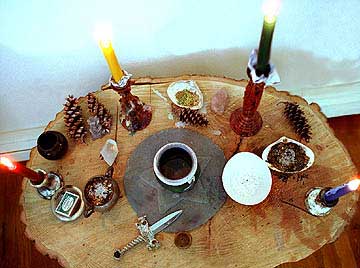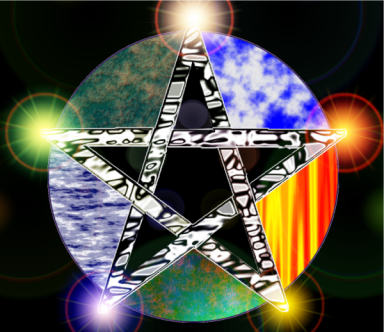 Ever since the so-called New Age era, I have been interested in the rise of Wicca and the whole neopagan scene. This trend raises all kinds of interesting issues of coven and state (Do conservative Christians really want equal access laws?), and you really can't talk about faith in popular culture, especially Hollywood, without dealing with the new consumer-friendly forms of paganism.
But the subject does freak many people out. I mean, you should have read my email after my infamous Mother's Day Scripps Howard column that began like this:
Ever since the so-called New Age era, I have been interested in the rise of Wicca and the whole neopagan scene. This trend raises all kinds of interesting issues of coven and state (Do conservative Christians really want equal access laws?), and you really can't talk about faith in popular culture, especially Hollywood, without dealing with the new consumer-friendly forms of paganism.
But the subject does freak many people out. I mean, you should have read my email after my infamous Mother's Day Scripps Howard column that began like this:
Few moments are as precious to mothers as the hushed rituals of bedtime.
Kristin Madden's memories include watching her 3-year-old son use the first personal altar he built on his father's old ironing board. He covered it with a blue cloth and added rocks, a baby tree, an earth flag and his hatching-dragon sculpture. Then the two of them would snuggle and talk about magic and the travels he would take in his dreams.
Finally, they would say a favorite prayer, such as: "Now I lay me down to bed. Great Spirit, bless my sleepy head. As I journey in my sleep, I know the Dragons my soul will keep. Mother Earth and Father Sky, watch over me here where I lie. Fairies please carry my love to all. Relations and loved ones, I do call."
Kristin Madden is a tutor in the Order of Bards, Ovates and Druids. Pagan mothers say bedtime prayers, too.
All of this is to say that I enjoyed reading Neela Banerjee's New York Times piece that ran with the headline "Wiccans Keep the Faith With a Religion Under Wraps."
The basic thesis is that there are people out there in Middle America who have converted to Wicca, yet elect to remain in the closet -- even to their parents -- because they fear adverse reactions. Here is a key section of the story:
Many Wiccans practice some form of magic or witchcraft, which they say is a way of affecting one's destiny, but which many outsiders see as evil. The Wiccan pentacle, a five-pointed star inside a circle, is often confused with symbols of Satanism. (The five points of the star represent the elements of nature -- earth, air, fire and water -- and the spirit, within the eternal circle of life.)
It is unclear how many Wiccans and other pagans there are. The 2001 American Religious Identification Survey by the City University of New York found that Wicca was the country's fastest-growing religion, with 134,000 adherents, compared with 8,000 in 1990. The actual number may be greater. ... Some people may have been unwilling to identify themselves as pagan or Wiccan for the survey. Others combine paganism with other religions.
Here is what bothers me.
 All through the piece we hear about people who do not understand Wicca and who threaten -- in one way or another -- those who practice this faith. Yet we never meet one or more of these people or even scholars who speak from this perspective (the history of Wicca is a minefield of controversial issues). The whole story presumes that these people are out there (and they are), yet we never hear from them.
All through the piece we hear about people who do not understand Wicca and who threaten -- in one way or another -- those who practice this faith. Yet we never meet one or more of these people or even scholars who speak from this perspective (the history of Wicca is a minefield of controversial issues). The whole story presumes that these people are out there (and they are), yet we never hear from them.
The more I thought about it, this reminded me of a classic American Journalism Review article titled "Pat Robertson's J-school." It opened with an anecdote about a Regent University publication's story about the rise of occult groups in the region.
But there's a problem, even beyond the assumption of direct connections between local covens and Satanism.
"Allure of the occult" tells the story of Satanist and vampire cults in this corner of Virginia. Student journalists [Sheila] Dorn and John David Kudrick turn to police detectives who track occultists, professors who study Satanism and news clippings about witches' covens in the area to write about what the inside headline calls "The evil that lurks in the darkness."
Nowhere in the 1,200-word story is there any attempt to speak to a Satanist, witch or vampire. The editors never even considered such an effort. It would have been, they say, un-Christian.
"We want to show our faith in every story," says Dorn, a tall, cheerful 26-year-old in flannel shirt, jeans and workboots. "We're not an investigative paper."
"We're saying, 'Hampton Roads, this is out there, you should know about it,'" Kudrick adds. "Our purpose in this story is to say we think this is something detrimental. It's a fallen world and we're in the end times."
I think we would all agree that this is a rather narrow and one-sided approach to journalism, even in a niche magazine. But this would be even more true in the hard-news pages of a major, mainstream newspaper.
So, in this Times piece, why do we hear about the critics of Wicca -- the assumption seems to be that they are mere fundamentalists -- yet we never hear from them? We never hear them describe their criticisms of Wicca, even though the entire piece pivots on their anti-Wiccan attitudes. Is the goal to stress that the views of the opponents of Wicca are, well, "detrimental"?
Strange. Spooky, even.
